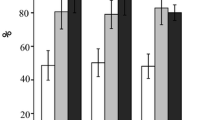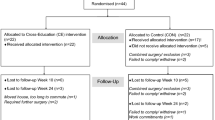Abstract
Purpose
To determine the most effective practices for quadriceps strengthening after ACL reconstruction.
Methods
An electronic search has been performed for the literature appearing from January 1990 to January 2012. Inclusion criteria were articles written in English, German or Dutch with unilateral ACL-reconstructed patients older than 13 years, RCT rehabilitation programmes containing muscle strengthening, protocol described in detail and time frame of measurements reported. Quadriceps muscle strength and patient-reported outcomes were the endpoints. Included studies were assessed on their methodological quality using the CONSORT Checklist.
Results
From 645 identified studies, 10 met the inclusion criteria. Seven studies found an increase in quadriceps strength after intervention programmes regardless of type of training. An eccentric exercise programme showed significantly better values for isometric quadriceps strength compared to a concentric exercise programme. The Tegner activity scale showed a significant increase in activity level for all training programmes. The Cincinnati Knee Rating System showed significant improvements in particular for the neuromuscular training group.
Conclusions
The evidence from this review indicates that eccentric training may be most effective to restore quadriceps strength, but full recovery may not be achieved with current rehabilitation practices. Neuromuscular training incorporating motor learning principles should be added to strengthening training to optimise outcome measurements.
Level of evidence
II.


Similar content being viewed by others
References
Adams D, Logerstedt DS, Hunter-Giordano A et al (2012) Current concepts for anterior cruciate ligament reconstruction: a criterion-based rehabilitation progression. J Orthop Sports Phys Ther 42(7):601–614
Ardern CL, Webster KE, Taylor NF, Feller JA (2010) Hamstring strength recovery after hamstring tendon harvest for anterior cruciate ligament reconstruction: a comparison between graft types. Arthroscopy 26(4):462–469
Ardern CL, Webster KE, Taylor NF, Feller JA (2011) Return to sport following anterior cruciate ligament reconstruction surgery: a systematic review and meta-analysis of the state of play. Br J Sports Med 45(7):596–606
Baumeister J, Reinecke K, Schubert M, Weiss M (2011) Altered electrocortical brain activity after ACL reconstruction during force control. J Orthop Res 29(9):1383–1389
Biau DJ, Tournoux C, Katsahian S, Schranz P, Nizard R (2007) ACL reconstruction: a meta-analysis of functional scores. Clin Orthop Relat Res 458:180–187
Chaudhari AM, Briant PL, Bevill SL, Koo S, Andriacchi TP (2008) Knee kinematics, cartilage morphology, and osteoarthritis after ACL injury. Med Sci Sports Exerc 40(2):215–222
Cohen J (1988) Statistical power analysis for the behavioral science. Lawrence Erlbaum Associates, Hillsdale, pp 25–26
Delince P, Ghafil D (2012) Anterior cruciate ligament tears: conservative or surgical treatment? A critical review of the literature. Knee Surg Sports Traumatol Arthrosc 20(1):48–61
Durham K, Van Vliet PM, Badger F, Sackley C (2009) Use of information feedback and attentional focus of feedback in treating the person with a hemiplegic arm. Physiother Res Int 14(2):77–90
Eitzen I, Holm I, Risberg MA (2009) Preoperative quadriceps strength is a significant predictor of knee function two years after anterior cruciate ligament reconstruction. Br J Sports Med 43(5):371–376
Feil S, Newell J, Minogue C, Paessler HH (2011) The effectiveness of supplementing a standard rehabilitation program with superimposed neuromuscular electrical stimulation after anterior cruciate ligament reconstruction: a prospective, randomized, single-blind study. Am J Sports Med 39(6):1238–1247
Gerber JP, Marcus RL, Dibble LE, Greis PE, Burks RT, Lastayo PC (2007) Safety, feasibility, and efficacy of negative work exercise via eccentric muscle activity following anterior cruciate ligament reconstruction. J Orthop Sports Phys Ther 37(1):10–18
Gerber JP, Marcus RL, Dibble LE, Greis PE, Burks RT, LaStayo PC (2009) Effects of early progressive eccentric exercise on muscle size and function after anterior cruciate ligament reconstruction: a 1-year follow-up study of a randomized clinical trial. Phys Ther 89(1):51–59
Gokeler A, Benjaminse A, Hewett TE, Lephart SM, Engebretsen L, Ageberg E, Engelhardt M, Arnold MP, Postema K, Otten E, Dijkstra PU (2011) Proprioceptive deficits after ACL injury: are they clinically relevant? Br J Sports Med 46(3):180–192
Gokeler A, Hof AL, Arnold MP, Dijkstra PU, Postema K, Otten E (2010) Abnormal landing strategies after ACL reconstruction. Scand J Med Sci Sports 20(1):e12–e19
Hart JM, Ko JW, Konold T, Pietrosimone B (2010) Sagittal plane knee joint moments following anterior cruciate ligament injury and reconstruction: a systematic review. Clin Biomech 25(4):277–283
Hartigan EH, Axe MJ, Snyder-Mackler L (2010) Time line for noncopers to pass return-to-sports criteria after anterior cruciate ligament reconstruction. J Orthop Sports Phys Ther 40(3):141–154
Heijne A, Werner S (2007) Early versus late start of open kinetic chain quadriceps exercises after ACL reconstruction with patellar tendon or hamstring grafts: a prospective randomized outcome study. Knee Surg Sports Traumatol Arthrosc 15(4):402–414
Heijne A, Werner S (2010) A 2-year follow-up of rehabilitation after ACL reconstruction using patellar tendon or hamstring tendon grafts: a prospective randomised outcome study. Knee Surg Sports Traumatol Arthrosc 18(6):805–813
Ingersoll CD, Grindstaff TL, Pietrosimone BG, Hart JM (2008) Neuromuscular consequences of anterior cruciate ligament injury. Clin Sports Med 27(3):383–404
Iriuchishima T, Shirakura K, Horaguchi T, Wada N, Sohmiya M, Tazawa M, Fu FH (2012) Age as a predictor of residual muscle weakness after anterior cruciate ligament reconstruction. Knee Surg Sports Traumatol Arthrosc 20(1):173–178
Kapreli E, Athanasopoulos S, Gliatis J, Papathanasiou M, Peeters R, Strimpakos N, Van Hecke P, Gouliamos A, Sunaert S (2009) Anterior cruciate ligament deficiency causes brain plasticity: a functional MRI study. Am J Sports Med 37(12):2419–2426
Knaepler H, Schenk C (1994) The new “Marburg rehabilitation concept”. “On the status of exercise equipment within the scope of rehabilitation of patients after surgery of the anterior cruciate ligament”. Aktuelle Traumatologie 24(1):17–23
Krishnan C, Williams GN (2009) Evoked tetanic torque and activation level explain strength differences by side. Eur J Appl Physiol 106(5):769–774
Landis JR, Koch GG (1977) The measurement of observer agreement for categorical data. Biometrics 33(1):159–174
Lepley LK, Palmieri-Smith R (2013) Effect of eccentric strengthening following anterior cruciate ligament reconstruction on quadriceps strength. J Sport Rehabil 22(2):150–156
Liu-Ambrose T, Taunton JE, MacIntyre D, McConkey P, Khan KM (2003) The effects of proprioceptive or strength training on the neuromuscular function of the ACL reconstructed knee: a randomized clinical trial. Scand J Med Sci Sports 13(2):115–123
Lohse KR, Sherwood DE (2012) Thinking about muscles: the neuromuscular effects of attentional focus on accuracy and fatigue. Acta Psychol (Amst) 140(3):236–245
Moher D, Hopewell S, Schulz KF, Montori V, Gotzsche PC, Devereaux PJ, Elbourne D, Egger M, Altman DG (2010) CONSORT 2010 Explanation and Elaboration: updated guidelines for reporting parallel group randomised trials. J Clin Epidemiol 63(8):e1–e37
Neeter C, Gustavsson A, Thomee P, Augustsson J, Thomee R, Karlsson J (2006) Development of a strength test battery for evaluating leg muscle power after anterior cruciate ligament injury and reconstruction. Knee Surg Sports Traumatol Arthrosc 14(6):571–580
Ortiz A, Olson S, Libby CL, Trudelle-Jackson E, Kwon YH, Etnyre B, Bartlett W (2008) Landing mechanics between noninjured women and women with anterior cruciate ligament reconstruction during 2 jump tasks. Am J Sports Med 36(1):149–157
Palmieri RM, Tom JA, Edwards JE, Weltman A, Saliba EN, Mistry DJ, Ingersoll CD (2004) Arthrogenic muscle response induced by an experimental knee joint effusion is mediated by pre- and post-synaptic spinal mechanisms. J Electromyogr Kinesiol 14(6):631–640
Palmieri-Smith RM, Thomas AC, Wojtys EM (2008) Maximizing quadriceps strength after ACL reconstruction. Clin Sports Med 27(3):405–424
Paterno MV, Schmitt LC, Ford KR, Rauh MJ, Myer GD, Huang B, Hewett TE (2010) Biomechanical measures during landing and postural stability predict second anterior cruciate ligament injury after anterior cruciate ligament reconstruction and return to sport. Am J Sports Med 38(10):1968–1978
Risberg MA, Holm I (2009) The long-term effect of 2 postoperative rehabilitation programs after anterior cruciate ligament reconstruction a randomized controlled clinical trial with 2 years of follow-up. Am J Sports Med 37(10):1958–1966
Risberg MA, Holm I, Myklebust G, Engebretsen L (2007) Neuromuscular training versus strength training during first 6 months after anterior cruciate ligament reconstruction: a randomized clinical trial. Phys Ther 87(6):737–750
Risberg MA, Mork M, Jenssen HK, Holm I (2001) Design and implementation of a neuromuscular training program following anterior cruciate ligament reconstruction. J Orthop Sports Phys Ther 31(11):620–631
Salem GJ, Salinas R, Harding FV (2003) Bilateral kinematic and kinetic analysis of the squat exercise after anterior cruciate ligament reconstruction. Arch Phys Med Rehabil 84(8):1211–1216
Schmitt LC, Paterno MV, Hewett TE (2012) The impact of quadriceps femoris strength asymmetry on functional performance at return to sport following anterior cruciate ligament reconstruction. J Orthop Sports Phys Ther 42(9):750–759
Sekir U, Gur H, Akova B (2010) Early versus late start of isokinetic hamstring-strengthening exercise after anterior cruciate ligament reconstruction with patellar tendon graft. Am J Sports Med 38(3):492–500
Shaw T, Williams MT, Chipchase LS (2005) Do early quadriceps exercises affect the outcome of ACL reconstruction? A randomised controlled trial. Aust J Physiother 51(1):9–17
Shelbourne KD, Klotz C (2006) What I have learned about the ACL: utilizing a progressive rehabilitation scheme to achieve total knee symmetry after anterior cruciate ligament reconstruction. J Orthop Sci 11(3):318–325
Shelbourne KD, Nitz P (1990) Accelerated rehabilitation after anterior cruciate ligament reconstruction. Am J Sports Med 18(3):292–299
Silvers HJ, Mandelbaum BR (2007) Prevention of anterior cruciate ligament injury in the female athlete. Br J Sports Med 41(Suppl 1):i52–i59
Thomee R, Kaplan Y, Kvist J, Myklebust G, Risberg MA, Theisen D, Tsepis E, Werner S, Wondrasch B, Witvrouw E (2011) Muscle strength and hop performance criteria prior to return to sports after ACL reconstruction. Knee Surg Sports Traumatol Arthrosc 19(11):1798–1805
Urbach D, Nebelung W, Becker R, Awiszus F (2001) Effects of reconstruction of the anterior cruciate ligament on voluntary activation of quadriceps femoris a prospective twitch interpolation study. J Bone Joint Surg Br 83(8):1104–1110
Valeriani M, Restuccia D, Di Lazzaro V, Franceschi F, Fabbriciani C, Tonali P (1999) Clinical and neurophysiological abnormalities before and after reconstruction of the anterior cruciate ligament of the knee. Acta Neurol Scand 99(5):303–307
Wilk KE, Macrina LC, Cain EL, Dugas JR, Andrews JR (2012) Recent advances in the rehabilitation of anterior cruciate ligament injuries. J Orthop Sports Phys Ther 42(3):153–171
Wright RW, Preston E, Fleming BC, Amendola A, Andrish JT, Bergfeld JA, Dunn WR, Kaeding C, Kuhn JE, Marx RG, McCarty EC, Parker RC, Spindler KP, Wolcott M, Wolf BR, Williams GN (2008) A systematic review of anterior cruciate ligament reconstruction rehabilitation: part II: open versus closed kinetic chain exercises, neuromuscular electrical stimulation, accelerated rehabilitation, and miscellaneous topics. J Knee Surg 21(3):225–234
Wulf G, McNevin N, Shea CH (2001) The automaticity of complex motor skill learning as a function of attentional focus. Q J Exp Psychol A 54(4):1143–1154
Wulf G, Shea C, Lewthwaite R (2010) Motor skill learning and performance: a review of influential factors. Med Educ 44(1):75–84
Xergia SA, McClelland JA, Kvist J et al (2011) The influence of graft choice on isokinetic muscle strength 4–24 months after anterior cruciate ligament reconstruction. Knee Surg Sports Traumatol Arthrosc 19(5):768–780
Author information
Authors and Affiliations
Corresponding author
Rights and permissions
About this article
Cite this article
Gokeler, A., Bisschop, M., Benjaminse, A. et al. Quadriceps function following ACL reconstruction and rehabilitation: implications for optimisation of current practices. Knee Surg Sports Traumatol Arthrosc 22, 1163–1174 (2014). https://doi.org/10.1007/s00167-013-2577-x
Received:
Accepted:
Published:
Issue Date:
DOI: https://doi.org/10.1007/s00167-013-2577-x




